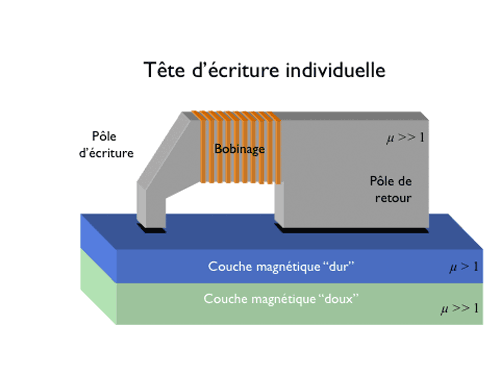Recording magnetic dots on the drum active layer

Flowing an electric current (≈100 mA) through the coil creates a magnetic flux that flows through the head body, emerges from the recording pole tip, crosses vertically the drum Co-Ni-P recording layer, and loops back through the drum high permeability Fe-Ni sub-layer and long return shoe.
According to the laws of physics (conservation of magnetic flux), the induction is quite large under the pole tip and much weaker in the return shoe area.
After the current vanishes, and relaxation of the drum layers occurs, a dot remains magnetized under the write pole tip, while no significant magnetization subsists under the return shoe.


With third generation printers, the recording poles in the new HD module (480 dpi), operate according to similar principle: Magnetization of the drum active layer is still vertical, even if a 2D return plane replaces the discrete return poles, while the flat etched coil brings in a much greater efficiency.


The essential difference is to be found at the level of the fabrication processes utilized. The discrete micro-mechanical methods are replaced by the collective processes of silicon-based micro-electronics. The new module sports a silicon chip that includes by co-integration 480 poles, coils and diodes.
The developpment of these new printing heads start in 1991 and the definition of 480 dpi incrises to 600 dpi in 2000.
To know more, you could see the presentation of B. Cherbuy (who begin and follow this project) : Congrès IS&T de New Orleans Octobre 1994
